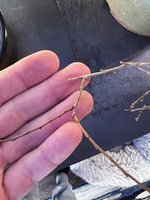Few Red Flags....
First Winter. (See next (..) )
Chinese Elm. (Prone to needing *acclimation)
Broke Dormancy. (But didn't break frost safety)
Brought it inside.....
At this point, when the pictured buds can still handle a frost, bringing it inside is fooling it into thinking it's warmer than it is, so it hastens it's breaking of dormancy beyond the point of frost protection and becomes susceptible the night, or day, you forget to bring it in.
This is why the "2-step" should be avoided and is a stupid concept.
The difficulty in getting out of it is usually because it starts the fall before.
"Dieback".....
A tree in nature won't get dieback without intervention. They are smarter than to waste energy in growth they can't sustain.
Only a late summer/early fall trauma causes the tree to utilize it's recovery method of "backbudding" and growing anew, which causes late growth susceptible to "dieback", because it didn't have time to achieve enough mass to build protection.
We have the responsibility to not cut too late to prevent this "dieback".
Since most of what we call "dieback" is due to the stu-step, and our cutting too late, I believe *acclimation is actually mostly a myth.
Sorce


